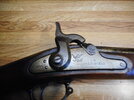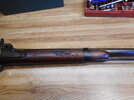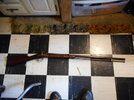You are using an out of date browser. It may not display this or other websites correctly.
You should upgrade or use an alternative browser.
You should upgrade or use an alternative browser.
1863 springfield converted to 16ga
- Thread starter kennedy
- Start date
hawg
Member
I kinda doubt your plastic wads and shot cups are going to work in it. They're not a good idea anyway.
kennedy
Member
no, going to use muzzle loader wads and shot
Last edited:
theotherwaldo
Member
Sears, Roebuck & Co. had these in their catalog back around 1896.
I found one of these hanging from a floor joist under an old house that Dad was thinking of buying in Southern Oregon.
His brother took it away from me and then proceeded to blow most of his right big toe off.
Big panic, rush to the E.R., what a mess.
Somewhere in the process the Springfield disappeared.
-And we didn't wind up buying the house.
I found one of these hanging from a floor joist under an old house that Dad was thinking of buying in Southern Oregon.
His brother took it away from me and then proceeded to blow most of his right big toe off.
Big panic, rush to the E.R., what a mess.
Somewhere in the process the Springfield disappeared.
-And we didn't wind up buying the house.
- Joined
- Dec 19, 2002
- Messages
- 22,553
Well that wasn't a pleasant experience theotherwaldo. Guess you uncle didn't learn about muzzle control.
Anyway, plastic is a PITA to scrub out of a barrel. An inline with a removable breechplug is easier. Stick with minie balls.
Anyway, plastic is a PITA to scrub out of a barrel. An inline with a removable breechplug is easier. Stick with minie balls.
Carl N. Brown
Member
My repro of the 1897 Sears catalog, shotgun section, has Springfield muskets cut down to make muzzleloading shotguns for $1.95
(back when $2 was toughly 2 ounces of silver).
(back when $2 was toughly 2 ounces of silver).
- Joined
- Dec 19, 2002
- Messages
- 22,553
I know Bannerman rebored many to smoothbore. I would use the traditional load for a ML shotgun:
1) powder
2) over powder wad
3) lubricated wad
4) shot
5) over shot wad.
You could use wasps nest, but you'd better pack it tight so there's push o the shot.
1) powder
2) over powder wad
3) lubricated wad
4) shot
5) over shot wad.
You could use wasps nest, but you'd better pack it tight so there's push o the shot.
Jackrabbit1957
Member
- Joined
- Apr 6, 2018
- Messages
- 2,896
I keep hearing about not shooting plastic wads in a muzzleloader shotgun, I guess I must be an idiot. Been hunting with a CVA double barrel for the last 40 years shooting dove and quail. I've used plastic wads continuously and never once had a problem with cleaning out plastic residue or even seeing it. I have heard if you're shooting trap or skeet it can be a problem on account of getting the barrel hot. This seems like a bumblebee being aerodynamicly unable to fly, the bee doesn't know that and continues to fly anyway.
Ugly Sauce
Member
- Joined
- Oct 26, 2020
- Messages
- 6,278
I've never tried a bare plastic wad, but I load a 12 gauge plastic cup-wad, inside a paper wrap in my Brown Bessie. Makes a "shot cartridge". Also allows more shot than the cup alone will hold. And the cup/plastic wad alone would be too small for my bore, which is 11 gauge. But it sure do work, don't need no stinking choke, that's for sure.  Congrats on the find, I'd love to find something like that which didn't cost a fortune.
Congrats on the find, I'd love to find something like that which didn't cost a fortune.
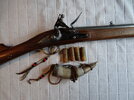
"T" for turkey, arrow for "this end up".

"T" for turkey, arrow for "this end up".
kennedy
Member
the barrel has been cut from 40 in to 32 in, otherwise I wouldThese are great candidates to restore back to military configuration. Reline the barrel, source an original stock, start shooting minies.
Many muskets after the Civil War were converted to shotguns and sold cheap.
AlexanderA
Member
In the OP's example, the barrel has been chopped. So you would need a new barrel, stock, and minor parts such as bands.These are great candidates to restore back to military configuration. Reline the barrel, source an original stock, start shooting minies.
Still, salvaging the lock, trigger guard, buttplate, etc., is nothing to sneeze at.
You end up with a hybrid original/reproduction, which is exactly what I got with my M1842, with original Harpers Ferry lock, barrel from Whitaker's, and stock from Dunlap's.
Total cost is probably comparable to that of an untouched original. The difference is that with a new barrel, you can be perfectly safe in shooting it.
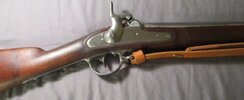
Lefty38-55
Member
If that load blows ‘donut hole’ patterns … where the center of the pattern has no shots in it, one cause of that is pellets impressing into the #3 lubricated 'cushion' wad. That makes that wad heavier, retaining energy and it flies through the group, blowing out the center of the pattern. A great way to cure it is to add a thin over shot wad on top of the cushion wad. I just tried this the other day and now my flintlock smoothie patterns great!1) powder
2) over powder wad
3) lubricated wad
4) shot
5) over shot wad.
So my loading sequence is:
1) Powder
2) Over powder or 'Nitro' wad (a hard disk wad to seal the powder)
3) 1/2 a lubricated cushion wad
4) Over shot wad
5) Shot
6) Over shot wad
Patterns amazing! But of course, there are zillion ways to load a MZL shotgun ...
Last edited:
There were 2 band muskets with shorter barrels. One easy example was the "Macon" conversion where the Confederate arsenal in Macon cut down battle damaged arms and reissued them.the barrel has been cut from 40 in to 32 in, otherwise I would
Jackrabbit1957
Member
- Joined
- Apr 6, 2018
- Messages
- 2,896
I go a different route, powder, plastic 1 1/8 shot cup/wad, shot, over shot wad. Also patterns great. Same thing with my tradegun.If that load blows ‘donut hole’ patterns … where the center of the pattern has no shots in it, one cause of that is pellets impressing into the #3 lubricated 'cushion' wad. That makes that wad heavier, retaining energy and it flies through the group, blowing out the center of the pattern. A great way to cure it is to add a thin over shot wad on top of the cushion wad. I just tried this the other day and now my flintlock smoothie patterns great!
So my loading sequence is:
1) Powder
2) Over powder or 'Nitro' wad (a hard disk wad to seal the powder)
3) 1/2 a lubricated cushion wad
4) Over shot wad
5) Shot
6) Over shot wad
Patterns amazing! But of course, there are zillion ways to load a MZL shotgun ...
hawg
Member
There were 2 band muskets with shorter barrels. One easy example was the "Macon" conversion where the Confederate arsenal in Macon cut down battle damaged arms and reissued them.
Those were 1842's and possibly some 1855's. As such a two band Springfield never officially existed.
- Joined
- Dec 19, 2002
- Messages
- 22,553
When I finish my trade gun, I'm going to try it both with and without your #4.If that load blows ‘donut hole’ patterns … where the center of the pattern has no shots in it, one cause of that is pellets impressing into the #3 lubricated 'cushion' wad. That makes that wad heavier, retaining energy and it flies through the group, blowing out the center of the pattern. A great way to cure it is to add a thin over shot wad on top of the cushion wad. I just tried this the other day and now my flintlock smoothie patterns great!
So my loading sequence is:
1) Powder
2) Over powder or 'Nitro' wad (a hard disk wad to seal the powder)
3) 1/2 a lubricated cushion wad
4) Over shot wad
5) Shot
6) Over shot wad
Patterns amazing! But of course, there are zillion ways to load a MZL shotgun ...
Lefty38-55
Member
Please be aware that donut patterns don’t show up on EVERY load or shot, sometimes only every 4 to 5 loads, so you really need to spend time with patterning paper.When I finish my trade gun, I'm going to try it both with and without your #4.
Ugly Sauce
Member
- Joined
- Oct 26, 2020
- Messages
- 6,278
I kind of like it "as-is", and don't think it would be worth the time and money to do any kind of restoration. There are plenty of un-molested originals around. I'd cut the barrel a little shorter, put an under-rib and wooden ram-rod on it, and take it on long hikes in the wilderness. 
Not as a production item, but with a war going on, lots of damaged stuff got cut down, modified and put back into the fight.Those were 1842's and possibly some 1855's. As such a two band Springfield never officially existed.
hawg
Member
Not as a production item, but with a war going on, lots of damaged stuff got cut down, modified and put back into the fight.
I'm just saying there's no records that I know of of an 1861 or later Springfield being cut down. There are records of 1842's being cut down. I'm not saying it didn't happen but since there's no records I'm thinking they would be rare. Maybe by the time they came around there was no real need to.
woodnbow
Member
- Joined
- Feb 19, 2007
- Messages
- 2,106
Not really into shotguns much myself but I’ve heard good things about the Sky Chief loads on another forum. To whit;
“Having been asked about the load and its makeup enough times, I will list the recipe here for reference sake.
I'm ignorant in the the ways of posting a link to some of the older threads regarding the load. If any of you are willing and able to do so, all the better. Some are a couple years old, maybe older. It seems some members are having difficulty finding them.
Powder charge
Nitro (hard) card
Shotload
Thin overshot card
Full fiber cushion wad*
*The cushion wad needs to be SATURATED (the wetter and heavier, the better) with oil. I like to use olive oil.
The load seems to shine best when used in cylinder bored guns.
Best of luck to all, Skychief.”
“Having been asked about the load and its makeup enough times, I will list the recipe here for reference sake.
I'm ignorant in the the ways of posting a link to some of the older threads regarding the load. If any of you are willing and able to do so, all the better. Some are a couple years old, maybe older. It seems some members are having difficulty finding them.
Powder charge
Nitro (hard) card
Shotload
Thin overshot card
Full fiber cushion wad*
*The cushion wad needs to be SATURATED (the wetter and heavier, the better) with oil. I like to use olive oil.
The load seems to shine best when used in cylinder bored guns.
Best of luck to all, Skychief.”
Evidently there were enough back during the War that the SAC (Small Arms Committee) of the N-SSA has sanctioned them for competition and there are some originals floating around. Some guys have built ones from parts and they're generally called "razeeds" in the N-SSA. That's not the correct term but the internal slang for a 2 band Springfield. Again, not a production item but not unknown either.I'm just saying there's no records that I know of of an 1861 or later Springfield being cut down. There are records of 1842's being cut down. I'm not saying it didn't happen but since there's no records I'm thinking they would be rare. Maybe by the time they came around there was no real need to.
Ugly Sauce
Member
- Joined
- Oct 26, 2020
- Messages
- 6,278
The cool thing about shotguns is...they throw big old hunking heavy giant round balls. I probably shoot more round ball through my smooth-bores than I do shot loads.Not really into shotguns much myself
- Joined
- Dec 19, 2002
- Messages
- 22,553
You haven't tried it though, have you?Sky Chief loads on another forum. To whit;
Powder charge
Nitro (hard) card
Shotload
Thin overshot card
Full fiber cushion wad*
*The cushion wad needs to be SATURATED (the wetter and heavier, the better) with oil. I like to use olive oil.”
The trouble I see is that while the oil saturated cushion wad has some advantages, there's nothing but the nitro card pushing on the shot. If it's nitro impregnated, it'll be partially consumed by the flame. Anyone care to pattern their gun in the traditional method, then with the Sky Chief's suggestion and then the traditional method with a Sky Chief an oil saturated full fibre cushion wad atop of the over shot wad?
Similar threads
- Replies
- 11
- Views
- 2K
- Replies
- 7
- Views
- 2K


